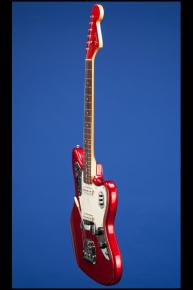Surfin' Bird
This 13 3/4-inch-wide Jaguar weighs 8.30 lbs. and has a "B" nut width of just over 1 5/8 inches and a scale length of 24 inches. Solid alder body, one-piece maple neck with a nice medium profile and a curved veneer rosewood fretboard with 22 original frets and inlaid pearloid dot position markers. Headstock with matching "Candy Apple Red" finish and decal with "Fender" logo in gold with black trim, "Jaguar" in black beside it, and four patent numbers in black below. "Offset Contour Body" decal at the ball end of the headstock. Single "butterfly" string tree. The neck is stamped "1 JAN 65B." Four-bolt neck plate with serial number "L59292" between the top two screws. Individual double-line Kluson Deluxe tuners with oval metal buttons and "D-169400 / Patent No." stamped on the underside. Two white oblong Strat-like pickups with notched metal side plates with perfectly matched outputs of 6.58k and 6.59k. Three-layer white over black plastic pickguard with ten screws. Two controls (one volume, one tone) and jack socket on lower metal plate adjoining pickguard on the treble side, circuit selector (rhythm/lead) slide switch and two roller controls (one volume, one tone) on upper metal plate adjoining pickguard on the bass side, and three pickup selector slide switches on metal plate inset into the pickguard on the treble side. The potentiometers are stamped "304 6438" and "304 6450" (Stackpole September and December 1964). Black plastic Jaguar knobs with white markings. Jazzmaster-type floating tremolo and bridge with adjustable mute. Complete with the original tremolo arm and bridge cover. There are two small areas of belt-buckle wear on the back of the body which have gone through the Candy Apple Red finish and show the silver undercoat. There are also a few small marks on the edges of the body - but the Candy Apple Red color is really rich and totally unfaded. The original frets show very little sign of wear and overall this fine 'Sixties Celebrity' guitar is in excellent plus (8.75) condition. Housed in the extremely rare original Fender top-of-the-line brown leather hardshell molded form-fit case with orange plush lining (8.75)
"Not content with the relatively expensive Jazzmaster, Fender introduced a new top-of-the-line model in 1962: the Jaguar. [The pricelist offered a basic Sunburst Jaguar at $379.50; a similar Jazzmaster was $349.50]. Another offset-waist multi-control instrument, the Jag seemed an attractive proposition, but still failed to dent the supremacy of Fender's dynamic duo, the Tele and the Strat...The Jag used a similar offset-waist body shape to the earlier Jazzmaster, and also shared that guitar's separate bridge and vibrato unit, although the Jaguar had the addition of a spring-loaded string mute at the bridge. Fender rather optimistically believed that players would prefer a mechanical string mute to the natural edge-of-the-hand method. They did not. There were some notable differences between the Jaguar and Jazzmaster. Visually, the Jag had distinctive chromed control panels, and was the first Fender with 22 frets. Its 24" (610mm) scale-length ('faster, more comfortable') was shorter than the Fender standard of 25" (635mm) and closer to that of Gibson. It gave the Jag a different playing feel compared to other Fenders. The Jaguar had better pickups than the Jazzmaster. They looked much like Strat units but had metal shielding added at the base and sides, no doubt as a response to the criticisms of the Jazzmaster's tendency to noisiness. The Jag's electrics were yet more complex than the Jazzmaster's, using the same rhythm circuit but adding a trio of lead-circuit switches...The Jaguar was offered from the start in four different neck widths, one a size narrower and two wider than normal (coded A, B, C or D, from narrowest to widest, with 'normal' B the most common)" (Tony Bacon, 50 Years of Fender, p. 36).
Candy Apple Red, introduced in 1963, "could be described as Fender's only true Custom Color as it was an original Fender 'mix' and not -- like most of the others -- a colour adopted from an existing automobile paint shade" (Tony Bacon and Paul Day, The Fender Book, p. 34). The undercoat on the body of this guitar is the earlier silver version, which gives a much brighter red color.
"The Trashmen, a Minneapolis rock & roll band, evolved from Jim Thaxter & the Travelers. They recorded one single under that name ("Sally Jo"/"Cyclone"). The group comprised of Tony Andreason (lead guitar), Dan Winslow (guitar/ vocals), Bob Reed (bass), and Steve Wahrer (drums/vocals). Unfairly depicted as a novelty act, the Trashmen were in actuality a top-notch rock & roll combo, enormously popular on the teen-club circuit, playing primarily surf music to a landlocked Minnesota audience. Drummer Steve Wahrer combined two songs by the Rivingtons ("The Bird's the Word" and "Pa Pa Ooh Mow Mow"), added freakish vocal effects and a pounding rhythm to the mix, and, by early 1964, the group was in the Top Ten nationwide with "Surfin' Bird." Though the group continued to release great follow-up singles and an excellent album, their moment in the sun had come and gone; they disbanded by late 1967/early 1968. They re-formed in the mid-'80s and continued to play locally until Wahrer's death. The Trashmen are revered by '60s collectors as one of the great American teen-band combos of all time, their lone hit exemplifying wild, unabashed rock & roll at its most demented, bare-bones-basic, lone-E-chord finest."
Translate:













